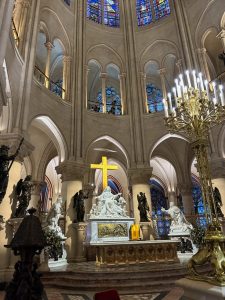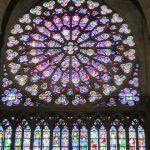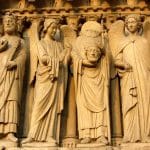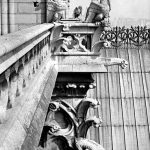| Notre Dame Paris | Yes, Notre Dame Cathedral reopened to the public in December 2024. This reopening will mark five years since the devastating fire of April 15, 2019, which destroyed the cathedral’s roof, spire, and parts of its interior. Restoration teams have worked meticulously to recreate the original Gothic design using traditional techniques and materials, with a focus on returning the structure to its pre-fire glory.

Notre Dame, December 2024 (very special Merci to Father Charles for the picture)
Notre Dame Cathedral’s grand reopening
The restoration process has been extensive, involving stabilizing the structure, restoring intricate architectural details, and recreating the iconic 19th-century spire designed by Eugène Viollet-le-Duc. Financed exclusively by donations, “the construction site of the century” will have cost some 700 million euros and mobilized around 2,000 professionals, including many craftsmen.
-
December 7 – Reopening ceremony
In a message read by the apostolic nuncio, the Pope Francis invites “all the baptized who will joyfully enter this cathedral to feel legitimate pride and to reclaim their heritage of faith. »
-
December 8 – First public mass
The first public mass since the 2019 fire will take place the following day. The inaugural mass and the consecration of the altar will take place at 10:30 a.m., presided over by the Archbishop of Paris Laurent Ulrich. More than 150 bishops from France and around the world, priests and faithful representing the parishes of the Diocese of Paris will be present. The cathedral will then be open to the public, until 10 p.m. the first week.The first mass open to the public will take place at 6:30 p.m. The public will once again be able to walk around the cathedral.
-
December 15 – Mass in tribute
To the Paris firefighters, the companions and all those who participated in the construction site during these five years of reconstruction.
-
December 16 – Ordinary life will resume.
To manage the flow of visitors, an online reservation system will be set up and a mobile application and the cathedral’s website will help the public. Reservations will be possible two days before the day of the visit. The gauge is between 1,900 and 3,000 people in the cathedral : https://www.notredamedeparis.fr/en/visit/practical-information/reservation/
Notre Dame of Paris nowadays
Before Notre-Dame Cathedral caught fire in 2019, it had the distinction of being the most visited monument in the world. 5 million people a year visit the Lincoln Memorial in Washington, D.C. 5 million people a year visit the Colosseum in Rome. 4 million go to the Statue of Liberty, and 3 million visit the pyramids of Giza in Egypt. 13 million were visiting Notre-Dame, an average of 30,000 visitors per day.
Parisian landscape for over 850 years
An emblematic monument of the capital, Notre-Dame de Paris cathedral is part of the Parisian landscape for over 850 years. The generosity following the fire in 2019 shows our attachment to Notre Dame and how it is part of our collective history. Scientists are leading Notre Dame’s restoration—and probing mysteries laid bare by its devastating fire. Listed in 1862 on the Historical Monuments and UNESCO World Heritage Site, Notre-Dame is a must see in Paris, the most visited place in Europe. Road distances in France are calculated from point 0. It is on the forecourt of the Cathedral.

One of the oldest cathedrals in the world
Dedicated to the Virgin Mary, Notre-Dame de Paris is one of the oldest Gothic Cathedrals in the world. Built between 1163 and 1245, the cathedral building has been renovated and restored several times. The most significant renovation took place in 1845 and took twenty-five years to complete. The cathedral has two towers standing 226 ft (69 metres) tall on its façade. Visitors will have to climb 387 steep steps.
Notre Dame Paris a Christian worship place
Notre-Dame remains above all dedicated to welcoming believers and to liturgical celebrations. It is one of the high places of Christian worship in France but also in the world. Indeed, the cathedral of Notre Dame hosts the world famous relics with the Christ crown of thorn bought by King Saint Louis (1214-1270). Kind Saint Louis also brought to Paris in the XIIIe century, a fragment of the cross, a nail of the cross from the treasury of the Holy Sepulcher in Jerusalem, offered to Charlemagne in 799 and the tunic of Saint Louis himself. Considered as a saint during his lifetime, he was canonized by the Catholic Church in 1297.
Notre Dame Paris Cathedral’s construction
Overall, building started in 1163 and lasted over 170 years. The bishops Eudes de Sully (1196-1208), Pierre de Nemours (1208-1219) and Guillaume de Seignelay (1220-1223) succeed each other until the cathedral is completed. Maurice de Sully’s project was revised around 1220-1230 to bring more light into the nave.
Maurice de Sully, bishop of Paris under King Louis VII
In the 12th century, Maurice de Sully, bishop of Paris under King Louis VII, launched the construction of a new cathedral in the heart of the Ile de la Cité, dedicated to the Virgin Mary. This space has been occupied since antiquity by numerous buildings, remains are visible in the Archaeological Crypt. Several decades are necessary for the completion of the works in order to raise the rib vaults, the flying buttresses, the frame…
Limestone, the forest and rose windows
Most of the limestone used came from quarries around Paris. Thousands of oaks were used for the construction of the framework, the “Forest of Notre-Dame”. After the fire, this structure was totally gone. The original plans chnaged in the first half of the 13th century with the addition of a water drainage system, the addition of a spire (which fall apart during the fire), the openwork of the towers and the drilling of 2 tall rose windows to allow more light. Those rose windows survived from the fire.

Stained glass of Notre Dame de Paris
The art of stained glass, appeared in the 12th century, was used from the earliest times of the construction of Notre-Dame. This project (same masters for the Sainte-Chapelle under king Saint Louis), enabled the mastery of the stained glass technique. It required significant financial means to obtain the metal oxides essential for the coloring of glass. Among the remarkable elements of Notre-Dame are its three rosettes, real stone lace and masterpieces of Gothic architecture. The western rose features the Madonna and Child at the center of the composition. The cathedral has also undergone many changes over the centuries and contains many masterpieces of sacred art. After the fire, relics and masterpieces are dispatched in safe places until the day will go back to Our Lady.

With its 127 meters long (416 foot) and 69 meters high 2 towers (226 foot and their 422 steps) Notre-Dame is one of the largest medieval cathedrals in Europe. Until the construction of the Eiffel Tower at the end of the 19th century, it was for hundreds of years the tallest monument in the capital.
Historical events
The story of the Cathedral is close to the History of France. Built in the 12th century, modified in the 18th century and then restored in the 19th century, it is the symbol of Christian worship in Paris over the centuries.
Medieval Time birth of Notre Dame Paris
In the 5th century, with king Clovis, Paris became the Christian capital of the kingdom of the Franks. It was then that a first Saint-Etienne cathedral was built in the 6th century. The city’s development began in the 12th century after the Norman invasions. Four popes stayed there during the century. The prosperous city was a place of artistic and intellectual exchanges, with colleges and a university of philosophy and theology such as the Sorbonne. This is how the story of Our Lady begins.
At the same time, the crusades to Jerusalem and the pilgrimages to Saint Jacques de Compostelle (Santiago de Compostela) displaced thousands of the faithful on the roads. The Ile de la Cité is an essential stopover to cross the Seine. In fact, the faithful flock to the district of the city. They generate businesses activities and offerings for worship. In this context, Maurice de Sully, bishop of Paris, undertook the construction of a new and vast cathedral to welcome the faithful.
In the 13th century, the population of Paris doubled. Saint Louis brought back from Jerusalem the relics of the passion of Christ in the cathedral in 1239. The cathedral thus became a high place of worship. It became a model of religious architecture with its pure Gothic style.
XVIIe century
In 1637, Louis XIII implores the Virgin Mary to give him a son. He undertook to consecrate his kingdom to Notre-Dame (the Virgin Mary), if she granted him the grace of having a son. Indeed, granting him an heir to succeed him on the throne of France. Proof of his devotion, he decided to have the choir of Our Lady modified and to offer a new high altar. Work began under Louis XIV, son of Louis XIII. At the center of the new architectural composition is a monumental statuary group: a white marble Pietà by Nicolas Coustou, a statue of Louis XIII offering his crown to Marie and finally the statue of Louis XIV imploring the Virgin, sculpted by Antoine Coysevox .
During the medieval time, Paris was one of the largest cities in the Western world and the Ile de la Cité was its center. Dense area, occupied by numerous buildings (religious, royal or private) and crisscrossed by winding and narrow alleys, the architects of Notre-Dame need to create a vast space. In the XII century, the cathedral of Saint-Etienne was destroyed leaving a space in front of the monumental portal. The square in front of Notre-Dame de Paris was born around 1160.
After the Revolution of 1789
Until the Revolution, Notre-Dame was one of the main Catholic places of worship in Paris. Kings, popes, bishops and great figures came to participate in major events in the kingdom.
When the hour of the Revolution came, Notre-Dame and its goods are seized by the young emerging Republic. In the political and social turmoil that followed Bastille on July 14, 1789, the municipality of Paris was born. Jean-Sylvain Bailly, first president of the National Assembly, is appointed head of Paris and becomes the city’s first mayor. Notre-Dame is selected to celebrate the event.
From July 17, 1789 to December 31 of the same year, the flags of the National Guard were blessed at Notre-Dame. The cathedral was vandalized, in particular the sculptures of the gallery of kings on the facade. It also became a voting place and then, between 1793 and 1795, a warehouse for Republic wines. After the law of May 31, 1795 granting the use of non-alienated buildings to various cults. The famous Abbé Grégoire (bishop of Loir-et-Cher then president of the Constituent Assembly) formed the “Catholic Society of Notre-Dame”. He received the keys Of Notre-Dame.

XIXe Century
During the 19th century, Notre-Dame de Paris once again became the privileged place for major national ceremonies. The Concordat of 1801 re-established Catholic worship. Notre-Dame de Paris returned to its original function. In 1804, during the coronation of Napoleon, the building was adorned with a wooden portico, cardboard and stucco, silk and velvet draperies. The walls are also whitewashed.
Between 1847 and 1864, Lassus and Viollet-le-Duc restored part of the sculpted decorations, and even reconstructed parts basing their work on old documents and works in the Cathedrals of Chartres, Reims and Amiens. It was during this restoration that Viollet-le-Duc was inspired to create the 56 chimera that adorn the tower gallery today. Paris saw its urban planning metamorphosed for the most part by the works of Baron Haussmann. Wide avenues are pierced, the buildings are standardized and aligned, places are created and, as seen previously, the relocation of the Hôtel-Dieu to the north of the Notre-Dame square allows to ventilate and enhance the cathedral .
In the XIX century, by a resurgence in popularity, the state decided to restore it in the 19th century. Thanks to the hunchback of Notre Dame novel, by Victor Hugo, it actually revived the attention to Our Lady.

XXe Century to Nowadays
May 9, 1945: Cardinal Suhard, welcomes General de Gaulle for the liberation of Paris from WW2. Moreover, he welcomed as well as members of the government and the ambassadors of the United States, the USSR and Great Britain. During the service a Te Deum thanksgiving for the victory is sung, the Marseillaise did follow.
In the second part of the 20th century, numerous restoration works were carried out. On the stained glass windows in particular. On December 24, 1948, the first mass in television history was filmed live from Notre-Dame de Paris. Following Vatican Council II and at the request of Monsignor Lustiger, a new altar was installed. In 2008, at the invitation of Monseigneur Vingt Trois, Pope Benedict XVI went to Paris for the Cathedral’s jubilee, its 850th anniversary. On this occasion, the large organ and lighting are renovated, eight new bells and the drone installed.

Notre Dame of Paris on fire
On the evening of April 15, 2019, Paris and the world watched Notre-Dame burning. President Emmanuel Macron vowed to rebuild Notre Dame by 2024. However, one year later Parisians are confined to their homes. France tries to prevent the coronavirus pandemic from overwhelming France’s hospitals and from tanking its economy. The cathedral, with 13 million visitors per year, closed to the public until December 2024.
Notre Dame cathedral’s grand reopening
Five years after a devastating fire, Notre-Dame Cathedral in Paris will reopen to the public on December 7, 2024. With a globally broadcast ceremony, a string of Masses, concerts and other events will take place. Millions of visitors are expected. Laurent Ulrich, Archbishop of Paris, said that we are going to recover the focal point of our life as a Church.
Notre-Dame is one of the most emblematic monuments of Paris. Notre Dame is more than a monument. Our Lady of Paris is above all a place of worship. Notre Dame welcomes any one like all our churches. Discover Notre Dame private tour.
Emy,

